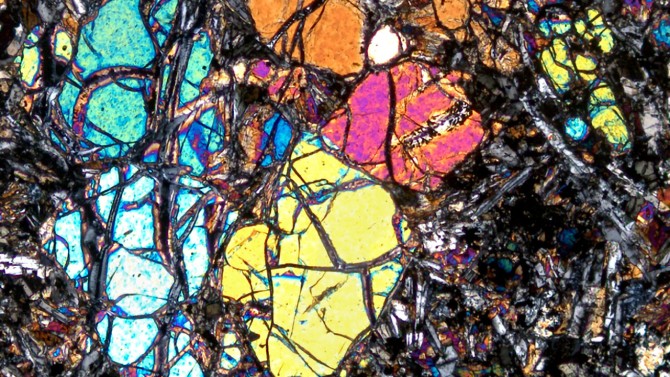
Scientists compile library for evaluating exoplanet water
By Blaine Friedlander, Cornell Chronicle
By probing chemical processes observed in the Earth’s hot mantle, Cornell scientists have started developing a library of basalt-based spectral signatures that not only will help reveal the composition of planets outside of our solar system, but also could demonstrate evidence of water on those exoplanets.
“When the Earth’s mantle melts, it produces basalts,” said Esteban Gazel, the Charles N. Mellowes Professor in Engineering in the Department of Earth and Atmospheric Sciences. Basalt, a gray-black volcanic rock found throughout the solar system, is a key recorder of geologic history, he said.
“When the Martian mantle melted, it also produced basalts. The moon is mostly basaltic,” he said. “We’re testing basaltic materials here on Earth to eventually elucidate the composition of exoplanets through the James Webb Space Telescope data.”
Gazel and first author Emily First, a former Cornell postdoctoral researcher and now an assistant professor at Macalester College in Minnesota, published “Potential for Observing Geological Diversity from Mid-infrared Spectra of Rocky Exoplanets,” on Nov. 14 in Nature Astronomy.
Understanding how minerals record the processes that created these rocks and their spectroscopic signatures is the first step in developing their library, Gazel said.
“We know that the majority of exoplanets will produce basalts, given that their host star metallicity will result in mantle minerals (iron-magnesium silicates) so that when they melt, phase equilibria (equilibrium between two states of matter) predicts that the resulting lavas will be basaltic,” Gazel said. “It will be prevalent not only in our solar system, but throughout the galaxy, too.”
First measured the emissivity – the extent to which a surface radiates the energy it encounters – of 15 basaltic samples for spectral signatures of what the space telescope’s mid-infrared spectrometer may detect.
Once basaltic melts erupt on an exoplanet and cool down, the basalts harden into solid rock, known on Earth as lava. This rock can interact with water, if present, which forms new hydrated minerals easy to spot in the infrared spectra. These altered minerals could become amphibole (a hydrous silicate) or serpentine (another hydrous silicate, which looks like a snake’s skin).
By examining small spectral differences between the basalt samples, scientists can in theory determine whether an exoplanet once had running surface water or water in its interior, said Gazel, a faculty fellow at the Cornell Atkinson Center for Sustainability.
Proof of water does not emerge instantly and further work is needed before this type of detection can be employed. It would take the James Webb Space Telescope (JWST) – about 1 million miles from Earth – dozens to hundreds of hours to focus on one system light-years away, then more time to analyze the data.
The research group – in looking for a rocky exoplanet to simulate its hypotheses and consider the 15 different signatures – used data from the super Earth exoplanet LHS 3844b, which orbits a red dwarf a little more than 48 light-years away.
Ishan Mishra, M.S. ’20, Ph.D. ’22, working in the laboratory of Nikole Lewis, associate professor of astronomy in the College of Arts and Sciences, wrote computer code modeling First’s spectral data to simulate how differing exoplanet surfaces might appear to the JWST.
Lewis said that modeling tools were first used for other applications.
“Ishan’s coding tools were used originally for studying icy moons in the solar system,” she said. “We are now finally trying to translate what we’ve learned of the solar system into exoplanets.”
“The goal was not to assess planet LHS 3844b specifically,” First said, “but rather to consider a plausible range of basaltic rocky exoplanets that could be observed by JWST and other observatories in the coming years.”
In terms of exoplanets, the researchers said exploration of rocky surfaces has been mostly limited to single data points – finding evidence of only type of chemical – in the scientific literature, but that is changing to multiple components as observers make use of the JWST.
By trying to tease out signatures related to mineralogy and bulk chemical composition – for example, how much silicon, aluminum and magnesium are in a rock – the geologists can tell a little more about the conditions under which the rock formed, the geologists said.
“On Earth, if you have basaltic rocks erupting from mid-ocean ridges deep on the ocean floor, versus those erupting at ocean islands like Hawaii,” First said, “you will notice some differences in the bulk chemistry. But even rocks of similar bulk chemistry can contain different minerals, so these are both important characteristics to examine.”
In addition to First, Gazel, Lewis and Mishra, co-authors are Jonathan Letai ’23, Northeastern University; and physicist Leonard Hanssen, Ph.D. ’85, recently retired from the National Institute of Standards and Technology.
Lewis is a faculty fellow in Cornell’s Carl Sagan Institute.
The National Science Foundation, the National Institute of Standards and Technology and the Heising-Simons Foundation/51 Pegasi b Fellowship supported this research.
Media Contact
Get Cornell news delivered right to your inbox.
Subscribe

